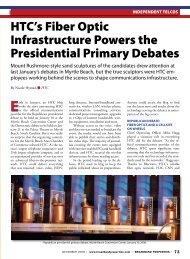March/April - Broadband Communities Magazine
March/April - Broadband Communities Magazine
March/April - Broadband Communities Magazine
You also want an ePaper? Increase the reach of your titles
YUMPU automatically turns print PDFs into web optimized ePapers that Google loves.
Cottage-style developments are<br />
the newest trend in off-campus<br />
student living. Combining many<br />
facets of new urbanism, a cottage student<br />
development is essentially a neighborhood<br />
of duplexes and Colorado-style<br />
homes (houses with open floor plans<br />
centered around large living spaces)<br />
leased by the bed. Some recent cottage<br />
developments include single-family<br />
homes intermixed with three- to sixunit<br />
attached homes or even traditional<br />
multifamily buildings. Every cottage<br />
development has a clubhouse that offers<br />
amenities on a par with any multifamily<br />
development.<br />
In the fall of 2011, Aspen Heights – a<br />
company founded with the goal of revolutionizing<br />
student living – approached<br />
RealPage with an interesting challenge:<br />
provide its residents with the same highspeed<br />
Internet access (HSIA) as multifamily<br />
developments without breaking<br />
the bank. The company had two new<br />
cottage-style developments under way.<br />
• Aspen Heights Auburn will include<br />
123 homes, 206 units and 600 beds<br />
and be served by Knology.<br />
• Aspen Heights San Antonio will have<br />
172 homes, 284 units and 844 beds<br />
and be served by Time Warner Cable.<br />
In building cottage developments, developers<br />
hope to blend the best aspects of<br />
purpose-built student housing and traditional<br />
single-family neighborhoods. For<br />
more than a decade, almost all purposebuilt<br />
student multifamily communities<br />
have used highly managed Ethernet<br />
networks to provide wired and wireless<br />
HSIA to residents. In a typical student<br />
building, a fiber backbone runs to build-<br />
Owners Corner<br />
Cottage-Style <strong>Broadband</strong><br />
Aspen Heights ups the ante at student cottage-style developments by<br />
providing HSIA services as good as or better than those in traditional<br />
multifamily buildings – contrary to conventional wisdom.<br />
By Henry Pye ■ RealPage Inc.<br />
from BCR/IDF<br />
(2) Strands SM fiber<br />
(1) series 6 coaxial<br />
ing or riser closets, and Cat 5e cables feed<br />
each unit. The solution is similar to what<br />
is used in local area networks (LANs) in<br />
fiber-fed commercial buildings.<br />
Ethernet, outfitted with managed<br />
switches and access points, has repeatedly<br />
proved to be the most cost-effective<br />
way to provide HSIA. However, the cost<br />
of running fiber to more than 100 structures,<br />
not to mention the expense of as<br />
many closets or surface-mounted enclosures,<br />
has been considered prohibitive<br />
about the author<br />
Henry Pye is vice president of resident technology services for RealPage (www.realpage.<br />
com). He can be reached at henry.pye@realpage.com.<br />
10 | BROADBAND COMMUNITIES | www.broadbandcommunities.com | <strong>March</strong>/april 2012<br />
28”<br />
8 Data or<br />
IP TV Drops<br />
to Outlets<br />
(if a duplex)<br />
Vented Cover<br />
(space for managed switch)<br />
120v Duplex<br />
6 Video Drops<br />
to Outlets<br />
(1) category 5e<br />
(1) series 6 coaxial<br />
(1) category 5e<br />
Living Room<br />
Bedroom Desk<br />
Data<br />
Video<br />
Data<br />
(1) category 5e<br />
(1) series 6 coaxial<br />
Kitchen<br />
Data<br />
6” above cabinet<br />
Closest to middle of unit<br />
Bedroom Dresser<br />
Figure 1: Each building in a cottage-style development has its own wiring closet – a combination<br />
communications room and distribution panel.<br />
Video<br />
for cottage developments. Instead, the<br />
sorts of cable modem or xDSL solutions<br />
used in neighborhoods of single-family<br />
homes were believed to be the best options<br />
for cottage developments. All a<br />
cottage developer needed to do was provide<br />
the phone or cable company with<br />
access to the joint trench, and the community<br />
would be ready to provide HSIA<br />
to its residents.<br />
Unfortunately, although cable and<br />
DSL services are well-suited for single-



